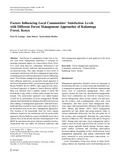| dc.contributor.author | Paul, M. Guthiga | |
| dc.contributor.author | John, Mburu | |
| dc.contributor.author | Karin, Holm-Mueller | |
| dc.date.accessioned | 2013-04-27T07:47:56Z | |
| dc.date.available | 2013-04-27T07:47:56Z | |
| dc.date.issued | 2008 | |
| dc.identifier.citation | Environmental Management (2008) 41 :696-706 DOl 10.1007 Is00267 -008-9080-z | en |
| dc.identifier.uri | http://link.springer.com/content/pdf/10.1007%2Fs00267-008-9080-z.pdf | |
| dc.identifier.uri | http://erepository.uonbi.ac.ke:8080/xmlui/handle/123456789/17264 | |
| dc.description.abstract | Satisfaction of communities living close to forests with forest management authorities is essential for ensuring continued support for conservation efforts. However, more often than not, community satisfaction is not systematically elicited, analyzed, and incorporated in conservation decisions. This study attempts to elicit levels of community satisfaction with three management approaches of Kakamega forest in Kenya and analyze factors influencing them. Three distinct management approaches are applied by three different authorities: an incentive-based approach of the Forest Department (FD), a protectionist approach of the Kenya Wildlife Service (KWS), and a quasi-private incentive-based approach of Quakers Church Mission (QCM). Data was obtained from a random sample of about 360 households living within 10-km radius around the forest margin. The protectionist approach was ranked highest overall for its performance in forest management. Results indicate that households are influenced by different factors in their ranking of management approaches. Educated households and those located far from market centers are likely to be dissatisfied with all the three management approaches. The location of the households from the forest margin influences negatively the satisfaction with the protectionist approach, whereas land size, a proxy for durable assets, has a similar effect on the private incentive based approach of the QCM. In conclusion, this article indicates a number of policy implications that can enable the different authorities and their management approaches to gain approval of the local communities. | en |
| dc.language.iso | en | en |
| dc.subject | Forest management approaches . Community satisfaction . Ordered probit . Kakamega forest . Kenya | en |
| dc.title | Factors Influencing Local Communities' Satisfaction Levels with Different Forest Management Approaches of Kakamega Forest, Kenya | en |
| dc.type | Article | en |

